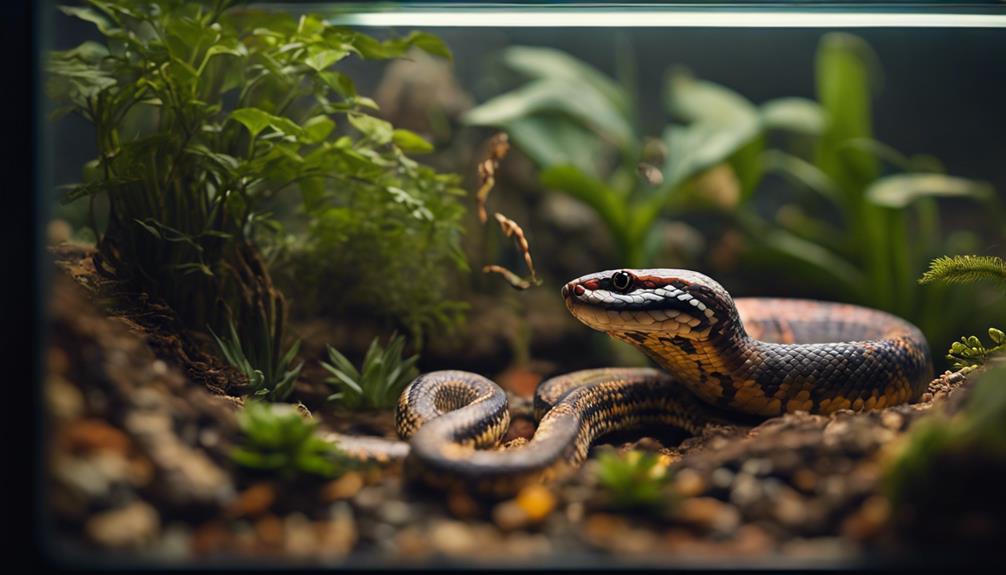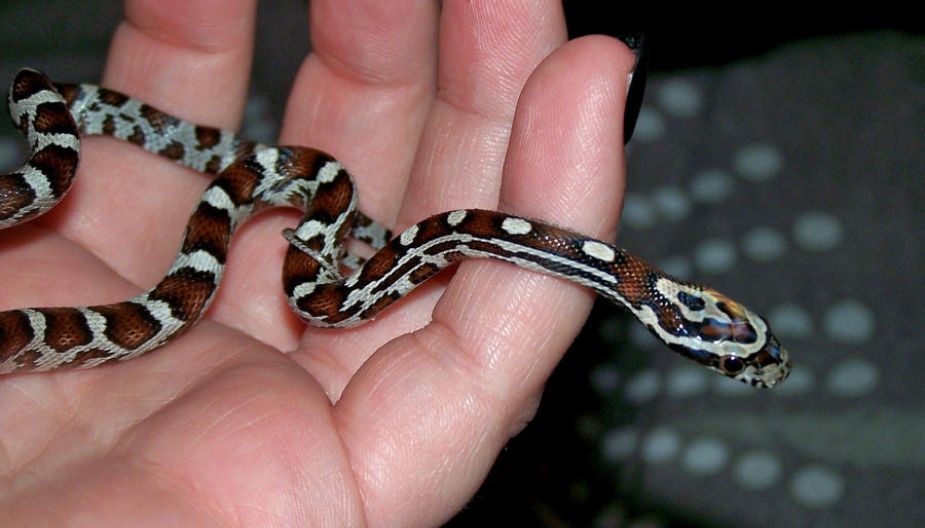Think of your corn snakes as unique entities, each with its distinct characteristics. Consider the challenge of merging these entities into one unified environment.
The task of keeping corn snakes together can be intriguing, but it demands meticulous thought and a keen eye for detail. As you delve into the complexities of shared living spaces and behavioral interactions, you’ll gain crucial knowledge that can improve your comprehension of these captivating reptiles.
Keep reading to learn about the critical factors that determine the success of cohabiting corn snakes.
Key Takeaways
- Corn snakes are solitary; shared habitats can lead to stress-related behaviors.
- Provide individual hiding spaces and basking spots to reduce conflicts.
- Feed snakes separately to avoid competition and aggression during mealtimes.
- Monitor behavior closely for signs of stress or illness, separating if necessary for safety.
Understanding Corn Snake Behavior
Understanding Corn Snake Behavior is essential for ensuring the well-being and proper care of these solitary reptiles. Corn snakes, known scientifically as Pantherophis guttatus, exhibit specific behaviors that are critical to comprehend when considering their housing arrangements.
These snakes are inherently solitary creatures, preferring to live and hunt alone in the wild. Their behavior is geared towards avoiding conflict, as they don’t rely on group dynamics for survival. When placed in shared habitats, corn snakes may display stress-related behaviors due to the lack of personal space and the presence of competitors. This can lead to aggression, dominance struggles over resources like food or shelter, and even cannibalistic tendencies, especially if size discrepancies exist.
When housing corn snakes together, it’s essential to provide adequate environmental enrichment to promote their well-being and minimize potential conflicts. To set up a shared habitat for adult corn snakes, follow these guidelines:
- Provide Sufficient Hiding Spaces: Make sure there’s at least one hide per snake to reduce stress levels and prevent territorial disputes. Corn snakes often seek shelter to feel secure, so having ample hiding spots is critical for their well-being.
- Offer Multiple Basking Spots: Guarantee there are several basking spots available, ideally one per snake, to allow each snake to regulate its body temperature effectively. Basking spots are vital for thermoregulation in corn snakes, enabling them to maintain their overall health.
- Incorporate Climbing Structures: Offer a variety of climbing branches and structures to create vertical space in the habitat. This helps prevent overcrowding and allows the snakes to exhibit their natural behaviors, promoting physical activity and mental stimulation.
Feeding Multiple Corn Snakes
To effectively feed multiple corn snakes housed together, it’s important to make sure each snake is fed separately to prevent competition and promote individual health and well-being. Feeding each snake individually allows you to monitor their feeding behavior closely, ensuring that each snake consumes the appropriate amount of food without interference from other snakes. By avoiding feeding multiple snakes together, you reduce the risk of competition, stress, and potential aggression during feeding time.
Provide a designated feeding area for each snake within the shared habitat. This helps minimize accidental bites or injuries that may occur when snakes compete for food. Keeping track of each snake’s feeding schedule, appetite, and any feeding issues is critical for identifying and addressing potential health concerns promptly. Adjust feeding frequencies and prey sizes based on each snake’s age, size, and metabolic rate to maintain their health and prevent overfeeding. By following these guidelines, you can make sure that each corn snake receives the necessary nutrition for the best well-being.
Monitoring Health and Well-being
To guarantee the optimum health and well-being of corn snakes housed together, it’s imperative to regularly monitor their body condition and weight. This practice allows you to catch any potential health issues early on and make certain that your snakes are thriving. Here are some key steps to effectively monitor the health of your corn snakes:
- Routine Body Condition Checks: Gently handle each snake to assess its body condition. Look for any signs of emaciation, bloating, or abnormal lumps that may indicate underlying health problems.
- Weight Monitoring: Regularly weigh your corn snakes using a reliable scale. Sudden weight loss or gain can be a red flag for various health issues, such as parasites or improper nutrition.
- Behavior Observation: Keep an eye out for any changes in behavior, such as increased aggression, lethargy, or appetite loss. These behavioral changes can signal stress or illness that requires attention.
Resolving Potential Behavior Issues
Addressing potential behavior issues in cohabitating corn snakes requires careful observation and proactive management strategies to guarantee their well-being and minimize risks of aggression or stress-related problems. When housing corn snakes together, it’s essential to create a suitable environment that includes both a cool side and a warm side to cater to their thermoregulation needs adequately. Behavior issues such as aggression, competition for resources, stress, and potential injuries due to territorial disputes can arise if these environmental requirements aren’t met.
To resolve behavior issues in cohabitating corn snakes, provide multiple hiding spots to allow snakes to escape from potential conflicts and reduce stress. Additionally, feeding the snakes separately can help prevent competition and aggression during feeding times. Monitoring interactions closely is crucial to identify any signs of aggression or stress promptly. If aggression or stress persists despite these measures, separating the corn snakes is necessary to prevent serious injuries or health issues. Understanding each snake’s personality and behavior patterns can also aid in preventing and addressing behavior issues effectively.
Frequently Asked Questions
Can Corn Snakes Be Housed Together?
You should not house corn snakes together. Doing so can lead to aggression, stress, and competition for resources, compromising their well-being. Individual housing prevents territorial disputes and guarantees each snake’s safety, health, and behavioral observations.
What Not to Do With a Corn Snake?
When dealing with a corn snake, avoid triggering aggression by mishandling or invading its space. Utilize proper handling techniques, respect their solitary nature, and never house them together to prevent stress and potential harm.
What Is the Perfect Corn Snake Enclosure?
For your corn snake, guarantee the enclosure size fits their growth stage. Provide temperature gradients to mimic their natural habitat. A properly sized vivarium with secure seals maintains heat and security, essential for the well-being of your pet.
Do Corn Snakes Need Company?
Corn snakes, as solitary species, do not require company for social behavior. Keeping them alone reduces stress, injuries, and guarantees proper care. Housing individually promotes their well-being, health, and prevents territorial conflicts or aggression.
Conclusion
Vital, by understanding corn snake behavior, setting up a shared habitat, feeding multiple snakes, monitoring health, and resolving behavior issues, you can guarantee the well-being and happiness of your corn snake companions.
By implementing proper care and housing practices, you can create a harmonious environment that promotes their overall health and happiness.
Remember, a well-maintained and enriched habitat is key to the longevity and vitality of your corn snakes.


